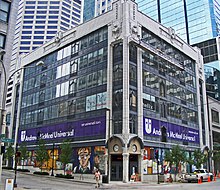
Kansas City is the largest city in Missouri by population and area. As of the 2020 census, the city had a population of 508,090 in 2020, making it the 36th most-populous city in the United States. It is the central city of the Kansas City metropolitan area, which straddles the Missouri–Kansas state line and has a population of 2,392,035. Most of the city lies within Jackson County, with portions spilling into Clay, Cass, and Platte counties. Kansas City was founded in the 1830s as a port on the Missouri River at its confluence with the Kansas River coming in from the west. On June 1, 1850, the town of Kansas was incorporated; shortly after came the establishment of the Kansas Territory. Confusion between the two ensued, and the name Kansas City was assigned to distinguish them soon after.

Fountain Place is a 60-story late-modernist skyscraper in downtown Dallas, Texas. Standing at a structural height of 720 ft (220 m), it is the fifth-tallest building in Dallas, and the 15th-tallest in Texas.. A new 45-story sibling tower, AMLI Fountain Place, has been built to its northwest on an adjacent lot.

The Kansas City metropolitan area is a bi-state metropolitan area anchored by Kansas City, Missouri. Its 14 counties straddle the border between the U.S. states of Missouri and Kansas. With 8,472 square miles (21,940 km2) and a population of more than 2.2 million people, it is the second-largest metropolitan area centered in Missouri and is the largest metropolitan area in Kansas, though Wichita is the largest metropolitan area centered in Kansas. Alongside Kansas City, Missouri, these are the suburbs with populations above 100,000: Overland Park, Kansas; Kansas City, Kansas; Olathe, Kansas; Independence, Missouri; and Lee's Summit, Missouri.

The Country Club Plaza is a privately-owned regional shopping center in the Country Club District of Kansas City, Missouri. Opened in 1923, it was the first planned suburban shopping center and the first regional shopping center to accommodate shoppers arriving by car.

Crown Center is a shopping center and neighborhood located near Downtown Kansas City, Missouri between Gillham Road and Main Street to the east and west, and between OK/E 22nd St and E 27th St to the north and south. The shopping center is anchored by Halls, a department store which is owned and operated by Hallmark Cards. The neighborhood contains numerous residences, retail establishments, entertainment venues, and restaurants including the American Restaurant, the only Forbes Travel Guide four-star restaurant in Missouri. It is home to Hallmark Cards, and the headquarters of Shook, Hardy & Bacon and Lathrop GPM, two of Kansas City's largest law firms.

Municipal Auditorium is a multi-purpose facility located in Kansas City, Missouri. It opened in 1935 and features Streamline Moderne and Art Deco architecture and architectural details.
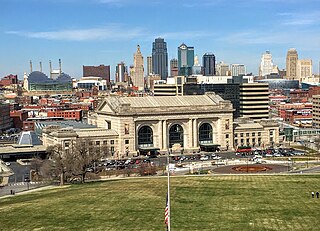
Downtown Kansas City is the central business district (CBD) of Kansas City, Missouri and the Kansas City metropolitan area. It is between the Missouri River in the north, to 31st Street in the south; and from the Kansas–Missouri state line eastward to Bruce R. Watkins Drive as defined by the Downtown Council of Kansas City; the 2010 Greater Downtown Area Plan formulated by the City of Kansas City defines the Greater Downtown Area to be the city limits of North Kansas City and Missouri to the north, the Kansas–Missouri state line to the west, 31st Street to the south and Woodland Avenue to the east. However, the definition used by the Downtown Council is the most commonly accepted.
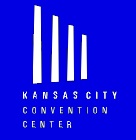
The Kansas City Convention Center, originally Bartle Hall Convention Center or Bartle Hall, is a major convention center in downtown Kansas City, Missouri, USA. It was named for Harold Roe Bartle, a prominent, two-term mayor of Kansas City in the 1950s and early-1960s. Its roof is suspended by four tall art deco inspired pylons, as a component of the Kansas City skyline.

The history of the Kansas City metropolitan area has records starting in the 19th century, as Frenchmen from St. Louis, Missouri moved up the Missouri River to trap for furs and trade with the Native Americans. The Kansas City metropolitan area, straddling the border between Missouri and Kansas at the confluence of the Kansas and Missouri Rivers, became a strategic point for commerce and security. Kansas City, Missouri was founded in 1838 and defeated its rival Westport to become the predominant city west of St. Louis. The area played a major role in the westward expansion of the United States. The Santa Fe, and Oregon trails ran through the area. In 1854, when Kansas was opened to Euro-American settlement, the Missouri-Kansas border became the first battlefield in the conflict in the American Civil War.

The architecture of Houston includes a wide variety of award-winning and historic examples located in various areas of the city of Houston, Texas. From early in its history to current times, the city inspired innovative and challenging building design and construction, as it quickly grew into an internationally recognized commercial and industrial hub of Texas and the United States.
Kivett & Myers was a Kansas City, Missouri architecture firm that pioneered the design of modern professional sports stadiums.

The architecture of metropolitan Detroit continues to attract the attention of architects and preservationists alike. With one of the world's recognizable skylines, Detroit's waterfront panorama shows a variety of architectural styles. The post-modern neogothic spires of One Detroit Center refer to designs of the city's historic Art Deco skyscrapers. Together with the Renaissance Center, they form the city's distinctive skyline.
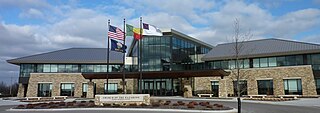
360 Architecture was an American architectural practice acquired by HOK in 2015. The firm provided services for a range of project types including corporate headquarters and commercial office buildings, sports arenas, stadiums and ballparks, municipal facilities, single- and multi-family residential, and mixed-use entertainment districts. The firm was headquartered in Kansas City, Missouri, with offices in Columbus Ohio; and San Francisco, California. As of 2014, the firm had a staff of 200 professionals.
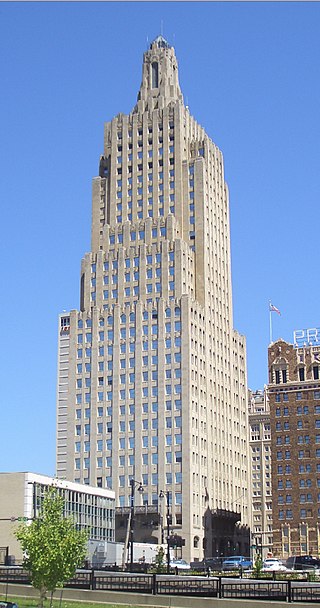
The Kansas City Power and Light Building is a landmark skyscraper located in Downtown Kansas City, Missouri. It was constructed by Kansas City Power and Light in 1931 as a way to promote new jobs in Downtown Kansas City. Since then, the Art Deco building has been a prominent part of Kansas City's skyline. The structure was the tallest building west of the Mississippi River upon its completion after succeeding the Smith Tower until the completion of the Space Needle in 1962. The east façade of the building faces the Power & Light District, and the building's iconic lantern appears on promotional materials and signage for the district and even Kansas City as a whole.

909 Walnut is a twin-spired, 35-story, 471-foot (144 m) residential skyscraper in Downtown Kansas City, Missouri. It was Missouri's tallest apartment building until the conversion of the Kansas City Power & Light building and the tenth-tallest habitable building in Missouri.

Community Christian Church was designed by Frank Lloyd Wright and sits across from the Country Club Plaza's main shopping district on Main Street at East 46th Street in Kansas City, Missouri. It is affiliated with the Christian Church denomination, which has a heavy representation in the Kansas City area.
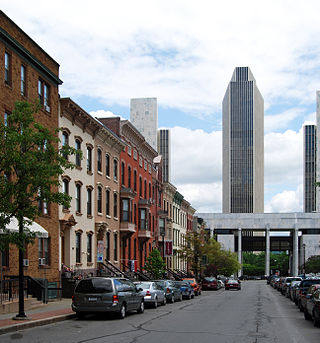
The architecture of Albany, New York, embraces a variety of architectural styles ranging from the early 18th century to the present. The city's roots date from the early 17th century and few buildings survive from that era or from the 18th and early 19th century. The completion of the Erie Canal in 1825 triggered a building boom, which continued until the Great Depression and the suburbanization of the area afterward. This accounts for much of the construction in the city's urban core along the Hudson River. Since then most construction has been largely residential, as the city spread out to its current boundaries, although there have been some large government building complexes in the modernist style, such as Empire State Plaza, which includes the Erastus Corning Tower, the tallest building in New York outside of New York City.

The architecture of Jacksonville is a combination of historic and modern styles reflecting the city's early position as a regional center of business. According to the National Trust for Historic Preservation, there are more buildings built before 1967 in Jacksonville than any other city in Florida, but it is also important to note that few structures in the city center predate the Great Fire of 1901. Numerous buildings in the city have held state height records, dating as far back as 1902, and last holding a record in 1981.






